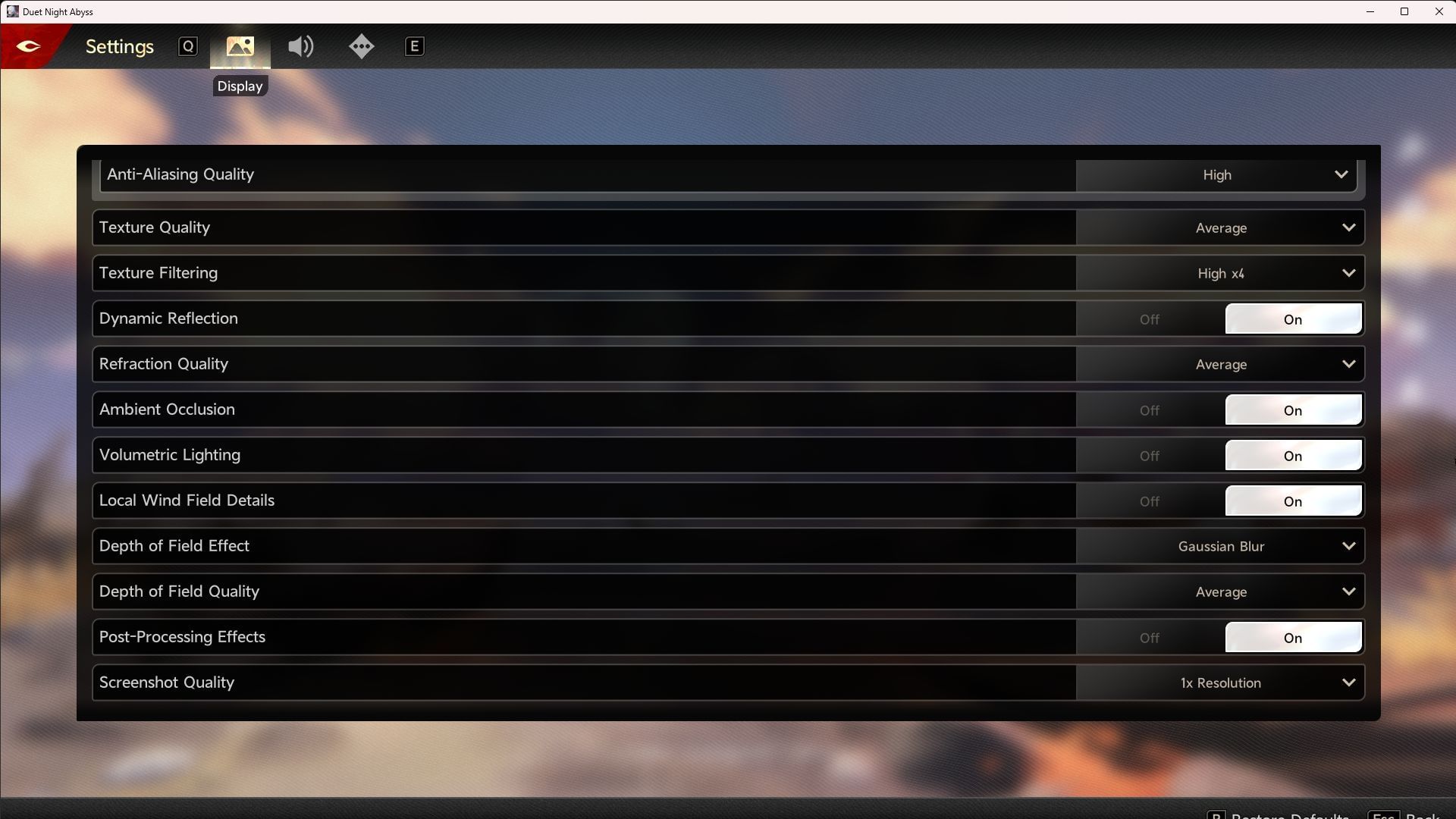Performance Optimization Overview
If your PC is struggling to run Duet Night Abyss smoothly, proper settings optimization can transform your experience from slideshow framerates to buttery-smooth gameplay. This guide provides hardware-specific configuration recommendations to maximize performance while maintaining visual quality appropriate for your system.
Rather than defaulting to “low” across the board, intelligent optimization tailors settings to your hardware capabilities, creating a customized performance profile that balances frame rates with visual fidelity.
System Requirements
Before adjusting settings, verify your system meets the recommended specifications for optimal performance:
Recommended System Requirements
- Operating System: Windows 10 64-bit
- Processor: Intel Core i7 (10th Gen) / AMD Ryzen X
- Graphics Card: GeForce RTX 20 Series or equivalent
- RAM: 16GB (recommended)
Systems below these specifications should prioritize low settings, while those exceeding them can explore medium or high configurations.
Optimal Settings by Hardware Tier

Complete Settings Configuration Table
| Setting | Low-End PC | Mid-Range PC | High-End PC |
|---|---|---|---|
| Graphics Filter | Professional | Professional | Professional |
| Display Mode | 1920×1080 | Native monitor resolution | Native monitor resolution |
| FSR/DLSS | On (Quality mode) | On (Balanced mode) | Optional (Performance mode or Off) |
| Frame Rate Cap | 60 FPS | 60 or 120 FPS | 120 FPS or Unlimited |
| Shadow Quality | Extremely Low/Low | Average | Extreme |
| Visual Effects Quality | Extremely Low | Average/High | High |
| UI Scaling | 100% | 100% | 100% |
| Teammate Effects | Block All | Block All | Block Some |
| V-Sync | Off | Off | Off |
| Anti-Aliasing | TAA – Low | TAA – Average | FilmicSMAA – High |
| Texture Quality | Low | Average | High |
| Texture Filtering | Low | High x4 | Very High x8 |
| Dynamic Reflection | Off | On | On |
| Refraction Quality | Off | Average | High |
| Ambient Occlusion | Off | On | On |
| Volumetric Lighting | Off | Off | On |
| Local Wind Field Details | Off | Off | On |
| Depth of Field Effect | Off | Gaussian Blur | Gaussian Blur |
| Depth of Field Quality | Low | Average | High |
| Post Processing Effects | Off | On | On |
Critical Settings Explained
FSR/DLSS: Performance Multiplier
AMD’s FidelityFX Super Resolution (FSR) and NVIDIA’s Deep Learning Super Sampling (DLSS) render the game at lower resolution then upscale intelligently, delivering significant performance gains with minimal visual compromise:
- Low-End Systems: Enable on Quality mode for best visual fidelity with performance boost
- Mid-Range Systems: Balanced mode provides optimal performance-quality trade-off
- High-End Systems: Optional—use Performance mode if targeting very high frame rates, or disable entirely
V-Sync: Why Keep It Off
V-Sync synchronizes frame output with monitor refresh rate to eliminate screen tearing. However, it introduces input latency. For competitive gaming or responsive controls, keeping V-Sync off is recommended across all hardware tiers. Use G-Sync/FreeSync if your monitor supports adaptive sync technology.
Shadow Quality: Major Performance Impact
Shadows are among the most GPU-intensive settings. Low-end systems should prioritize Extremely Low or Low settings here for substantial performance gains. The visual difference between Low and Extreme is noticeable but not gameplay-critical.
Teammate Effects: Competitive Advantage
Blocking teammate visual effects reduces visual clutter and improves performance during multiplayer encounters. Even high-end systems benefit from “Block Some” rather than showing all effects, as it maintains visibility during chaotic battles.
Fine-Tuning Process
Use these configurations as starting points, then adjust based on your specific hardware and preferences:
Step-by-Step Optimization
- Apply baseline settings for your hardware tier
- Launch the game and enter a typical gameplay scenario
- Monitor frame rates using in-game counter or overlay (MSI Afterburner, GeForce Experience)
- Adjust individual settings up or down based on performance headroom
- Test different scenarios—single player, multiplayer, intense combat
- Prioritize settings that matter most to your experience
Settings Priority Order
If you need additional performance, reduce settings in this order (highest impact first):
- Shadow Quality
- Volumetric Lighting
- Dynamic Reflection
- Visual Effects Quality
- Post Processing Effects
- Texture Quality (if VRAM-limited)
Additional Optimization Tips
System-Level Optimizations
- Update GPU drivers: Latest drivers often include game-specific optimizations
- Close background applications: Free up system resources before playing
- Enable Game Mode (Windows): Prioritizes gaming performance
- Monitor temperatures: Thermal throttling reduces performance significantly
- Verify game files: Corrupted files can cause performance issues
Hardware Considerations
- RAM: 16GB minimum recommended; 8GB may cause stuttering
- Storage: Install on SSD rather than HDD to reduce loading times and potential stutters
- GPU VRAM: High texture settings require adequate VRAM—reduce if experiencing stuttering
For comprehensive PC gaming optimization beyond Duet Night Abyss, consult NVIDIA’s system optimization guide.
Common Issues and Solutions
Low Frame Rates Despite Optimization
- Verify system meets minimum requirements
- Check GPU drivers are current
- Monitor GPU/CPU temperatures for thermal throttling
- Ensure game is using dedicated GPU (not integrated graphics)
Stuttering or Frame Drops
- Close background applications consuming resources
- Reduce texture quality if VRAM-limited
- Install game on SSD instead of HDD
- Disable overlays (Discord, GeForce Experience) temporarily
Visual Artifacts or Glitches
- Update graphics drivers
- Verify game file integrity through launcher
- Reset settings to default and reconfigure
- Reduce overclocks if system is overclocked
Share your thoughts if you find this helpful


